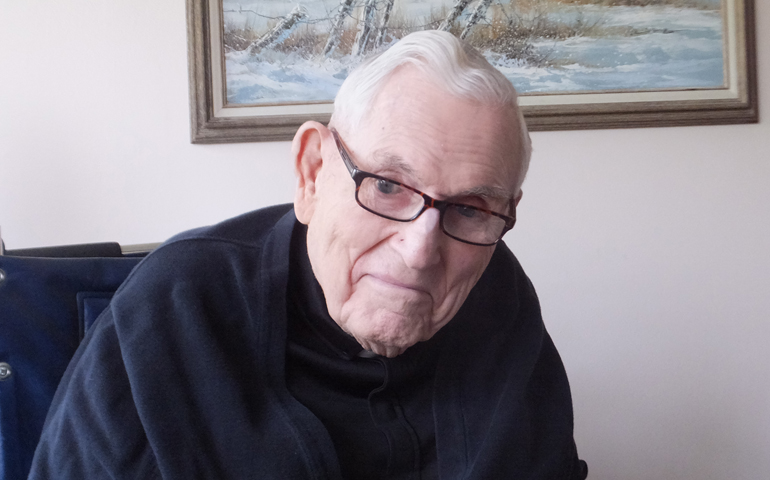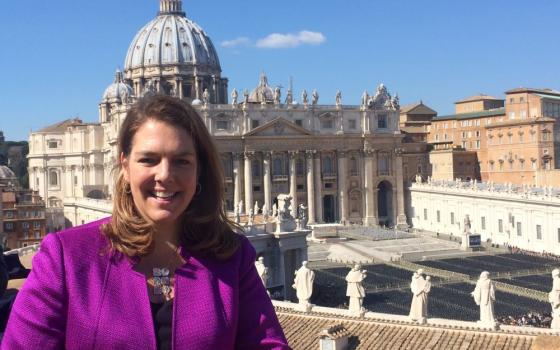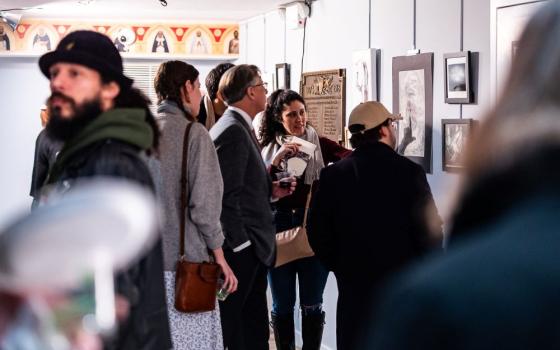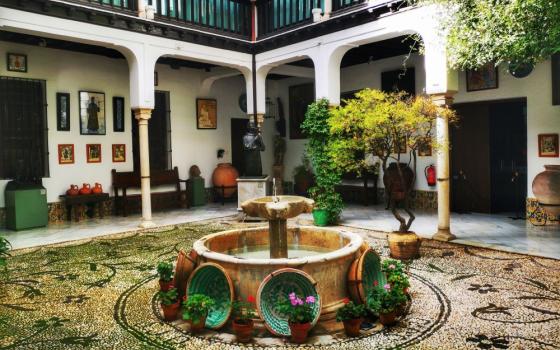
Archbishop Peter Leo Gerety (Patricia Lefevere)
Archbishop Peter Leo Gerety, the world's oldest Catholic prelate, will mark 104 years of life July 19. But first he will celebrate 50 years as a bishop June 1 and 77 years as a priest June 29.
That's a lot of numbers for an old man to remember and the Newark archbishop emeritus is not getting worked up about any of them. "How many are coming?" he asks his assistant, Paula Flynn, who visits him four or five days a week at St. Joseph's Home for the Elderly here.
The nursing home, run by the Little Sisters of the Poor, will be the venue for a Mass, commemorating his half century of episcopal ordination June 1, and a luncheon. Gerety has been at St. Joseph's three years after living many years at the Newark archdiocese's home for retired priests in Rutherford, N.J.
"How many did you say are coming?" Gerety asks again. "About 25 of your closest priest friends," she tells him.
Flynn and Gerety were out May 17, the evening before NCR visited the archbishop. Flynn drove him to a dinner to benefit the Scholarship Fund for Inner City Children, a program Gerety initiated with local firms and businessmen 33 years ago while serving 12 years as Newark's archbishop. Hundreds of elementary school pupils have been helped to further their Catholic education by receiving one of the scholarships.
The archbishop sits in a wheelchair during our interview, but later vacates the chair and ambles with the aid of a walker to the dining room where we eat lunch. In his sitting room are photos of Gerety and four popes -- Paul VI, John Paul II, Benedict XVI and Francis. The current Holy Father is shown greeting Gerety last September during an evening prayer service at St. Patrick's Cathedral in New York.
"I thought I might get to see him; I never expected he would come over to greet and bless me," the archbishop said.
When asked what changes he had seen in the church over a century of life and almost eight decades of priesthood, Gerety contemplated the matter and then fell silent.
"Your question is too wide," he responded, his hands up at his sides as if he was about to squeeze an accordion.
But he held on to the thread of the question and offered some thoughts on the Second Vatican Council, calling it "the biggest thing of my life as far as ecclesiology goes."
This NCR reporter attended his address to almost 1,300 people – many of them bishops and priests – at his testimonial dinner in 1987 and more recently his talk on Vatican II’s Constitution on the Church in the Modern World, given at Church of the Presentation in Upper Saddle River, N.J., in late 2005. After recalling both talks, he agreed that his comments at both these events contained the essence of how he believed the church has changed over his lifetime.
Catholic roots
No matter how old Gerety becomes, the church will always be 20 times older than his lifespan, he noted.
"Like a family we have roots," he said, indicating the church's roots extend back 20 centuries. From his earliest youth, he has felt a part of that history. It was not a history he learned in Catholic schools. There were none in Shelton, Conn., when he was growing up there in the 1920s and 1930s.
His Catholic teachers were his parents and his classroom was the kitchen table and living room of a house that contained nine Catholic boys. Peter Leo, named after his late father, was the eldest and is the only one of the nine still alive. Some 80 family members, including cousins, nieces, nephews, their spouses, children and grandchildren gathered for "Uncle Leo's" centenary in 2012. Each year several family members continue to mark his birthday.
A nephew recalled sailing with him on his 31-foot ocean-going sloop, which Gerety frequently navigated along the Northeast coast from Portland, Maine, where he began his episcopal career in 1966, to the Connecticut ports near his childhood home, to New Haven, where he served as a parish priest among the poor, largely African-Americans living in the projects. Asked if he was sorry he sold his sailboat a few years ago, the archbishop threw up his hands, inquiring: "I sold it?" to the delight of his guests.
Meanwhile back to the matter of Vatican II, Gerety recalled his ordination to the priesthood in Paris in 1939 and his early life as a student and altar boy in the pre-Vatican II era.
"I was really living in the waning years of the Counter-Reformation," that had followed the Protestant reformers of the 16th century. The period lasted several centuries and produced "great saints, great missionary activity, great music and art" as well as the Latin Mass, which Gerety said he loved.
But as a seminarian at St. Sulpice in Paris reading the works of theologians and church historians in their original French, Gerety became aware that "the world had moved on and time had come for changes." Wouldn't it be wonderful if his Brievary could be in English rather than Latin, if Mass could be in English or French or Spanish, all of which he knew well?
He and other young priests "lived in hope" that the election of Pope John XXIII would bring change. But "God surely has a sense of humor," he mused, adding that no one expected the 77-year-old pontiff to be more than "a transitional pope." Yet Pope John challenged church leaders to bring the modern world into contact with the life-giving energies of the Gospel, Gerety said.
"Right away we sensed that the old defensive attitude to developments in the history of the world was coming to an end," he said.
Gerety lauded two other popes, Pius XII, who though "austere and forbidding in personality" laid the groundwork for the Council in his approach to the modernization of scripture, theology and liturgy studies, he said, and Paul VI, who carried on the work after John's death. "He also named me bishop a year after the close of the Council," he said.
Gerety had to learn quickly how to be a bishop in the new era that was emerging. He said he gleamed much from the pastoral style of John XXIII, who was "not concerned with condemnations," but who wanted the church to "make use of the medicine of mercy rather than that of severity."
While he read and studied the Council's documents on "the inner-life of the church" and its relations to other faiths, on liturgy and on the Bible, he was drawn most to Gaudium et Spes or the Pastoral Constitution on the Church in the Modern World.
The document dealt with "all the joys and sorrows of humankind." Gerety saw this. In his 20 years as an active bishop, he took his lead from Gaudium et Spes. It prompted him to involve the laity in the work of the Lord in this world. It helped him to see that family life must be strengthened and that separated, divorced and remarried Catholics must not be alienated from their church, but could be ministered to by an office in the archdiocese for those with disrupted marriages.
Laying a foundation
Coming to a city torn by racial strife in the late 1960s, Gerety continued the pastoral approach among African-Americans that he had begun in New Haven. He was quick to appoint the fourth* black bishop in the nation, the late Joseph Francis, and to encourage Francis to author the U.S. Bishops' Pastoral Letter on Racism a few years later.
Not one to boast of his efforts or their effects, Gerety did raise his hands over lunch to comment: "Without lay people nothing would happen."
His friend Msgr. Thomas Ivory, who was also at the table, reminded him of how in his first year as Newark archbishop, he had accepted Ivory's suggestion for a spiritual renewal program, involving all the archdiocese's parishes and agencies. It was to run over a three-year span so as to lay the foundation for the evangelization needed for the adult catechumenate.
Ivory, then in his first year as archdiocesan religious education director, also recommended that Fr. Tom Kleissler in the Office of Pastoral Renewal become involved as the "lead agent" in the program, an idea Gerety readily accepted, Ivory reminded him with a nod.
The two Fr. Toms gathered a team of pastoral consulters and began a year of planning. After initial feedback from a variety of pilot parishes, RENEW was launched in 200 parishes -- 80 percent of those in the archdiocese. As word spread, facilitated by Kleissler's organizational skills, RENEW was embraced and took root in 126 U.S. dioceses and in 14 nations around the world, "translated and transculturalized" for each country, Ivory said.
Besides the priority which Gerety gave to prayer, race relations, family life and spiritual renewal in the four-county urban see of 1.3 million Catholics, he also went to town to secure the best lay leaders to help erase a $40 million debt that he inherited when becoming archbishop in 1974. His gentle spirit, ability to delegate and especially his openness to the Holy Spirit were the hallmarks of his episcopal leadership, Ivory said. He also pointed to his keen intellect and his habit of sharing with his priests and people so many of the books and authors with whom he was conversant, many of them works by French and Spanish theologians.
When asked what he considered his legacy or greatest achievement, Gerety would not shift even a shoulder into the limelight. He said the church is still in "a period of transition and rapid cultural change." But he cited "the enormous renewal that has occurred, the deepening of prayer life and the involvement of men and women of the laity in the work of the Lord in this world."
"Love is the test given to us by the Lord Himself," he said, echoing Jesus' words: "Love one another as I have loved you. … Where love is absent, He is too," said the oldest bishop in the world, before leaving for his siesta.
*An earlier version of this story incorrectly listed Francis as the first black bishop in the nation.
[Patricia Lefevere is a longtime NCR contributor.]




